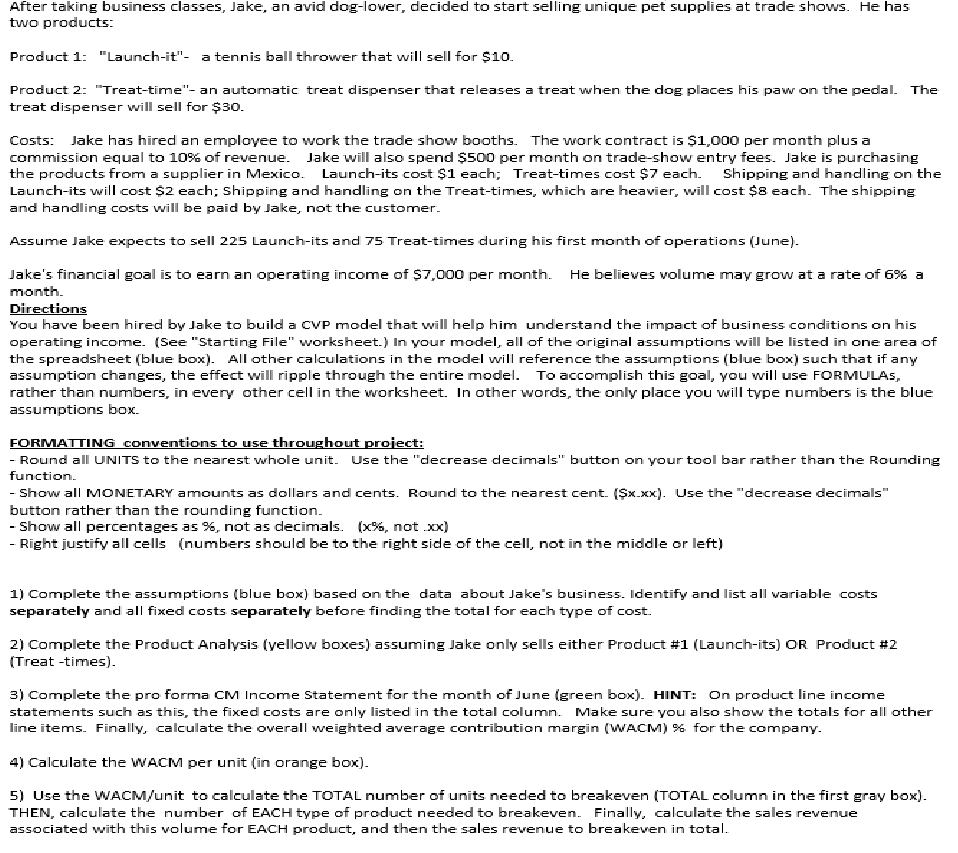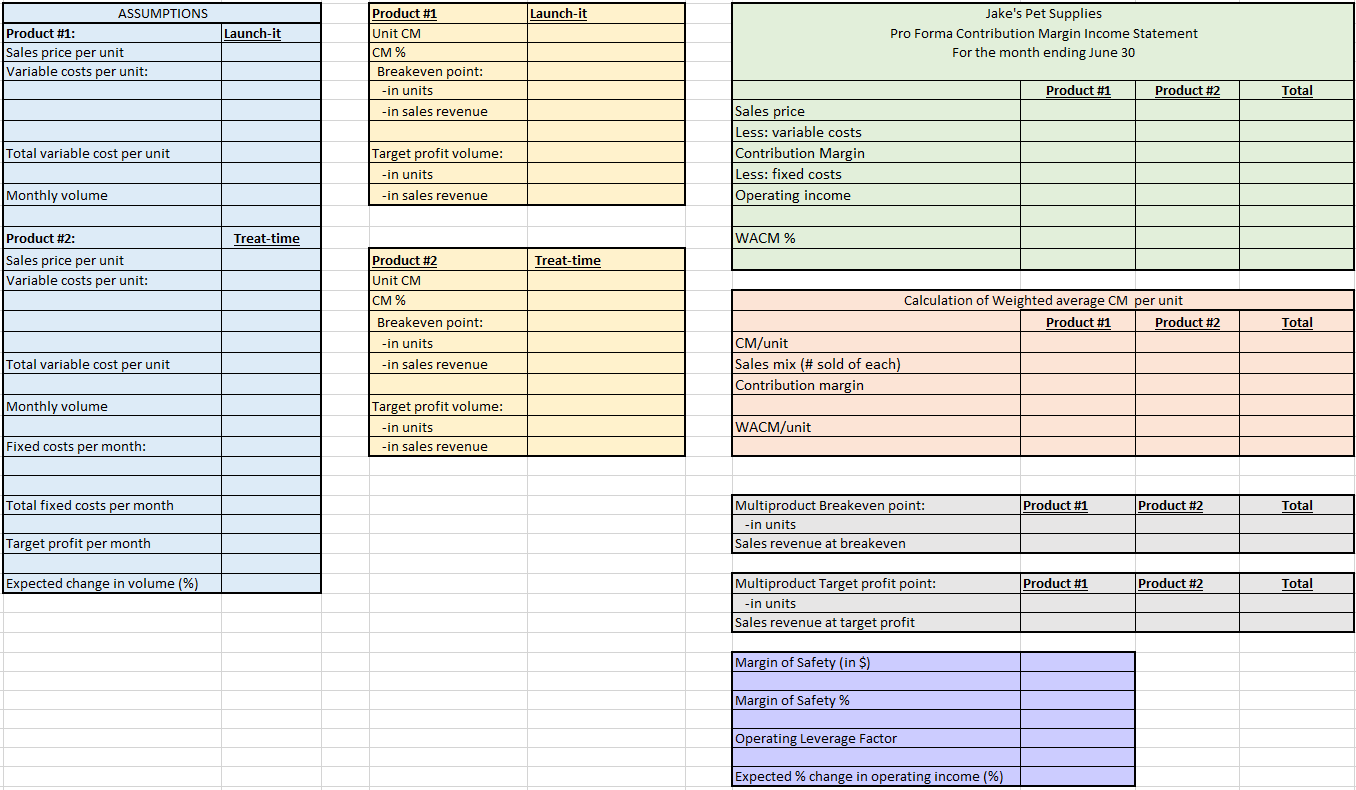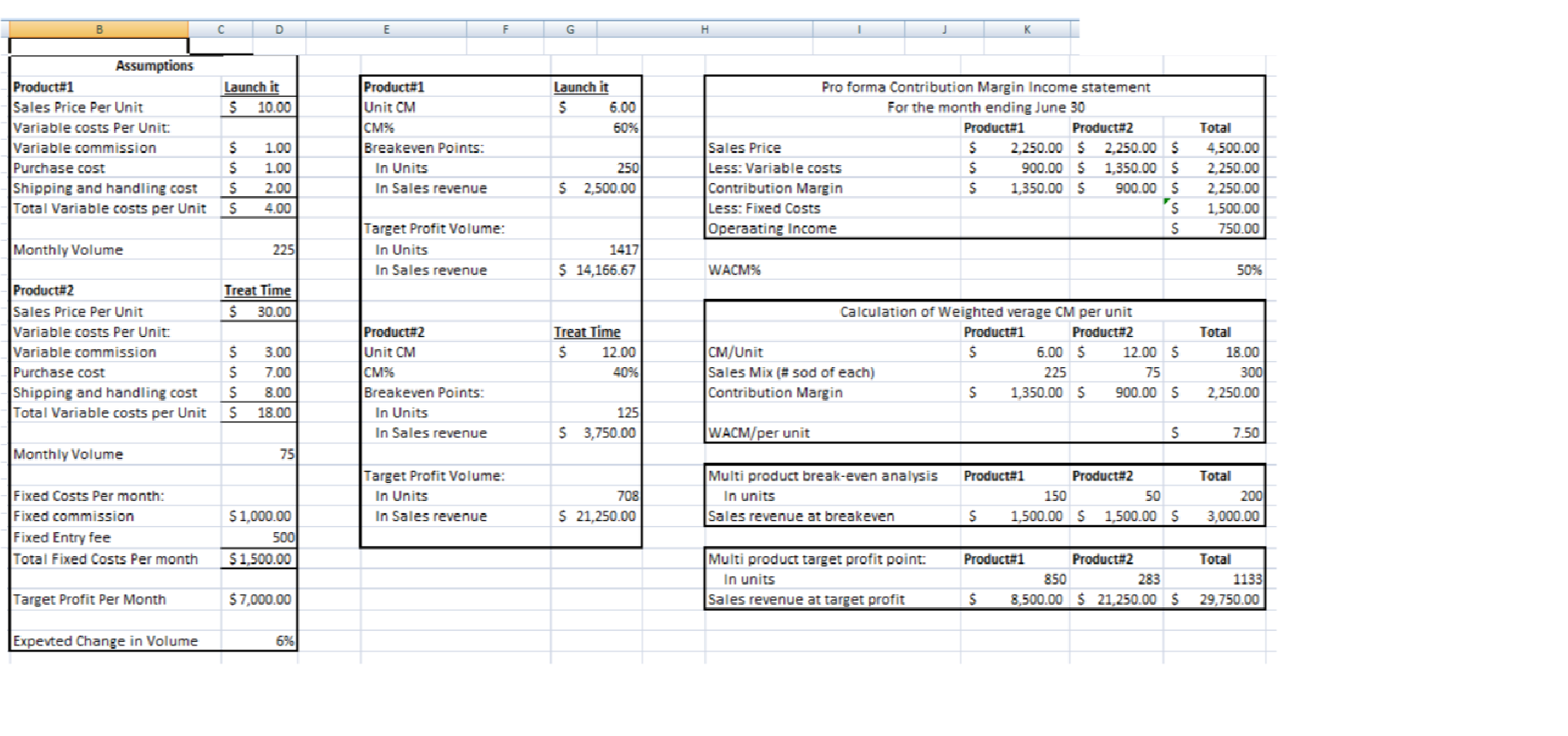


 PLEASE HELP BY ENTERING EQUATIONS IN EXCEL FORMAT INTO EACH BOX. I'M HAVING A TON OF DIFFICULTY UNDERSTANDING WHICH EQUATIONS GO WHERE! THANK YOU :)
PLEASE HELP BY ENTERING EQUATIONS IN EXCEL FORMAT INTO EACH BOX. I'M HAVING A TON OF DIFFICULTY UNDERSTANDING WHICH EQUATIONS GO WHERE! THANK YOU :)
After taking business classes, Jake, an avid dog-lover, decided to start selling unique pet supplies at trade shows. He has two products: Product 1: "Launch-it"- a tennis ball thrower that will sell for $10. Product 2: "Treat-time"- an automatic treat dispenser that releases a treat when the dog places his paw on the pedal. The treat dispenser will sell for $30. Costs: Jake has hired an employee to work the trade show booths. The work contract is $1,000 per month plus a commission equal to 10% of revenue. Jake will also spend $500 per month on trade-show entry fees. Jake is purchasing the products from a supplier in Mexico. Launch-its cost $1 each; Treat-times cost $7 each. Shipping and handling on the Launch-its will cost $2 each; Shipping and handling on the Treat-times, which are heavier, will cost $8 each. The shipping and handling costs will be paid by Jake, not the customer. Assume Jake expects to sell 225 Launch-its and 75 Treat-times during his first month of operations (June). Jake's financial goal is to earn an operating income of $7,000 per month. He believes volume may grow at a rate of 6% a month. Directions You have been hired by Jake to build a CVP model that will help him understand the impact of business conditions on his operating income. (See "Starting File" worksheet.) In your model, all of the original assumptions will be listed in one area of the spreadsheet (blue box). All other calculations in the model will reference the assumptions (blue box) such that if any assumption changes, the effect will ripple through the entire model. To accomplish this goal, you will use FORMULAS, rather than numbers, in every other cell in the worksheet. In other words, the only place you will type numbers is the blue assumptions box. FORMATTING conventions to use throughout project: - Round all UNITS to the nearest whole unit. Use the "decrease decimals" button on your tool bar rather than the Rounding function. - Show all MONETARY amounts as dollars and cents. Round to the nearest cent. (Sx_xx). Use the "decrease decimals" button rather than the rounding function. - Show all percentages as %, not as decimals. (x%, not.xx) - Right justify all cells (numbers should be to the right side of the cell, not in the middle or left) 1) Complete the assumptions (blue box) based on the data about Jake's business. Identify and list all variable costs separately and all fixed costs separately before finding the total for each type of cost. 2) Complete the Product Analysis (yellow boxes) assuming Jake only sells either Product #1 (Launch-its) OR Product #2 (Treat-times). 3) Complete the pro forma CM Income Statement for the month of June (green box). HINT: On product line income statements such as this, the fixed costs are only listed in the total column. Make sure you also show the totals for all other line items. Finally, calculate the overall weighted average contribution margin (WACM) % for the company. 4) Calculate the WACM per unit (in orange box). 5) Use the WACM/unit to calculate the TOTAL number of units needed to breakeven (TOTAL column in the first gray box). THEN, calculate the number of EACH type of product needed to breakeven. Finally, calculate the sales revenue associated with this volume for EACH product, and then the sales revenue to breakeven in total. 6) Use the WACM/unit to calculate the total number of units needed to achieve Jake's target profit (TOTAL column in the second gray box). THEN, calculate the number of EACH type of product needed to achieve the target profit. Finally, calculate sales revenue associated with this volume for EACH product, and then the sales revenue in total. 7) Calculate the margin of safety (MOS) using June sales as the expected sales (purple box). Calculate the MOS in terms of sales revenue and as a percentage. Also calculate the current operating leverage factor (round to the nearest 2 decimal places) and use it to determine the expected percentage change in operating income stemming from an expected change in sales volume. Launch-it Launch-it ASSUMPTIONS Product #1: Sales price per unit Variable costs per unit: Jake's Pet Supplies Pro Forma Contribution Margin Income Statement For the month ending June 30 Product #1 Unit CM CM% Breakeven point: -in units -in sales revenue Product #1 | Product #2 Total Total variable cost per unit Target profit volume: -in units -in sales revenue Sales price Less: variable costs Contribution Margin Less: fixed costs Operating income Monthly volume Treat-time WACM % Product #2: Sales price per unit Variable costs per unit: Treat-time Product #2 Unit CM CM % Breakeven point: -in units -in sales revenue Total Calculation of Weighted average CM per unit Product #1 Product #2 CM/unit Sales mix (# sold of each) Contribution margin Total variable cost per unit Monthly volume Target profit volume: -in units -in sales revenue WACM/unit Fixed costs per month: Total fixed costs per month Product #1 Product #2 Total Multiproduct Breakeven point: -in units Sales revenue at breakeven Target profit per month Expected change in volume (%) Product #1 Product #2 Total Multiproduct Target profit point: -in units Sales revenue at target profit Margin of Safety (in $) Margin of Safety % Operating Leverage Factor Expected % change in operating income (%) | C D Launch it $ 10.00 Launch it $ 6.00 60% Assumptions Product#1 Sales Price Per Unit Variable costs Per Unit: Variable commission Purchase cost Shipping and handling cost Total Variable costs per Unit Product#1 Unit CM CM% Breakeven Points. In Units In Sales revenue $ $ $ 5 1.00 1.00 2.00 4.00 Pro forma Contribution Margin Income statement For the month ending June 30 Product#1 Product#2 Sales Price $ 2,250.00 $ 2,250.00 Less: Variable costs $ 900.00 $ 1,350.00 Contribution Margin $ 1,350.00 $ 900.00 Less: Fixed Costs Operaating Income 250 2,500.00 Total 4,500.00 2,250.00 2,250.00 1,500.00 750.00 $ $ $ S 5 $ Monthly Volume 225 Target Profit Volume: In Units In Sales revenue 1417 14,166.67 $ WACM% 50% Treat Time $ 30.00 Product#2 Sales Price Per Unit Variable costs Per Unit: Variable commission Purchase cost Shipping and handling cost Total Variable costs per Unit Treat Time $ 12.00 40% 5 5 5 Calculation of Weighted verage CM per unit Product#1 Product#2 CM/Unit $ 6.00 5 12.00 Sales Mix (# sod of each) 225 Contribution Margin $ 1,350.00 $ 900.00 3.00 7.00 8 .00 18.00 Product#2 Unit CM CM% Breakeven Points In Units In Sales revenue 75 Total 18.00 300 2,250.00 5 5 5 125 5 3,750.00 WACM/per unit 57.50 Monthly Volume Total Target Profit Volume: In Units In Sales revenue 7081 Multi product break-even analysis In units Sales revenue at breakeven Product#1 Product#2 150 50 S 1,500.00 $ 1,500.00 200 5 21,250.00 5 3,000.00 Fixed Costs Per month: Fixed commission Fixed Entry fee Total Fixed Costs Per month $1,000.00 500 $1,500.00 Multi product target profit point: In units Sales revenue at target profit Productii Product#2 850 283 $ 8,500.00 $ 21,250.00 Total 1133 29,750.00 Target Profit Per Month $7,000.00 $ Expevted Change in Volume 6% After taking business classes, Jake, an avid dog-lover, decided to start selling unique pet supplies at trade shows. He has two products: Product 1: "Launch-it"- a tennis ball thrower that will sell for $10. Product 2: "Treat-time"- an automatic treat dispenser that releases a treat when the dog places his paw on the pedal. The treat dispenser will sell for $30. Costs: Jake has hired an employee to work the trade show booths. The work contract is $1,000 per month plus a commission equal to 10% of revenue. Jake will also spend $500 per month on trade-show entry fees. Jake is purchasing the products from a supplier in Mexico. Launch-its cost $1 each; Treat-times cost $7 each. Shipping and handling on the Launch-its will cost $2 each; Shipping and handling on the Treat-times, which are heavier, will cost $8 each. The shipping and handling costs will be paid by Jake, not the customer. Assume Jake expects to sell 225 Launch-its and 75 Treat-times during his first month of operations (June). Jake's financial goal is to earn an operating income of $7,000 per month. He believes volume may grow at a rate of 6% a month. Directions You have been hired by Jake to build a CVP model that will help him understand the impact of business conditions on his operating income. (See "Starting File" worksheet.) In your model, all of the original assumptions will be listed in one area of the spreadsheet (blue box). All other calculations in the model will reference the assumptions (blue box) such that if any assumption changes, the effect will ripple through the entire model. To accomplish this goal, you will use FORMULAS, rather than numbers, in every other cell in the worksheet. In other words, the only place you will type numbers is the blue assumptions box. FORMATTING conventions to use throughout project: - Round all UNITS to the nearest whole unit. Use the "decrease decimals" button on your tool bar rather than the Rounding function. - Show all MONETARY amounts as dollars and cents. Round to the nearest cent. (Sx_xx). Use the "decrease decimals" button rather than the rounding function. - Show all percentages as %, not as decimals. (x%, not.xx) - Right justify all cells (numbers should be to the right side of the cell, not in the middle or left) 1) Complete the assumptions (blue box) based on the data about Jake's business. Identify and list all variable costs separately and all fixed costs separately before finding the total for each type of cost. 2) Complete the Product Analysis (yellow boxes) assuming Jake only sells either Product #1 (Launch-its) OR Product #2 (Treat-times). 3) Complete the pro forma CM Income Statement for the month of June (green box). HINT: On product line income statements such as this, the fixed costs are only listed in the total column. Make sure you also show the totals for all other line items. Finally, calculate the overall weighted average contribution margin (WACM) % for the company. 4) Calculate the WACM per unit (in orange box). 5) Use the WACM/unit to calculate the TOTAL number of units needed to breakeven (TOTAL column in the first gray box). THEN, calculate the number of EACH type of product needed to breakeven. Finally, calculate the sales revenue associated with this volume for EACH product, and then the sales revenue to breakeven in total. 6) Use the WACM/unit to calculate the total number of units needed to achieve Jake's target profit (TOTAL column in the second gray box). THEN, calculate the number of EACH type of product needed to achieve the target profit. Finally, calculate sales revenue associated with this volume for EACH product, and then the sales revenue in total. 7) Calculate the margin of safety (MOS) using June sales as the expected sales (purple box). Calculate the MOS in terms of sales revenue and as a percentage. Also calculate the current operating leverage factor (round to the nearest 2 decimal places) and use it to determine the expected percentage change in operating income stemming from an expected change in sales volume. Launch-it Launch-it ASSUMPTIONS Product #1: Sales price per unit Variable costs per unit: Jake's Pet Supplies Pro Forma Contribution Margin Income Statement For the month ending June 30 Product #1 Unit CM CM% Breakeven point: -in units -in sales revenue Product #1 | Product #2 Total Total variable cost per unit Target profit volume: -in units -in sales revenue Sales price Less: variable costs Contribution Margin Less: fixed costs Operating income Monthly volume Treat-time WACM % Product #2: Sales price per unit Variable costs per unit: Treat-time Product #2 Unit CM CM % Breakeven point: -in units -in sales revenue Total Calculation of Weighted average CM per unit Product #1 Product #2 CM/unit Sales mix (# sold of each) Contribution margin Total variable cost per unit Monthly volume Target profit volume: -in units -in sales revenue WACM/unit Fixed costs per month: Total fixed costs per month Product #1 Product #2 Total Multiproduct Breakeven point: -in units Sales revenue at breakeven Target profit per month Expected change in volume (%) Product #1 Product #2 Total Multiproduct Target profit point: -in units Sales revenue at target profit Margin of Safety (in $) Margin of Safety % Operating Leverage Factor Expected % change in operating income (%) | C D Launch it $ 10.00 Launch it $ 6.00 60% Assumptions Product#1 Sales Price Per Unit Variable costs Per Unit: Variable commission Purchase cost Shipping and handling cost Total Variable costs per Unit Product#1 Unit CM CM% Breakeven Points. In Units In Sales revenue $ $ $ 5 1.00 1.00 2.00 4.00 Pro forma Contribution Margin Income statement For the month ending June 30 Product#1 Product#2 Sales Price $ 2,250.00 $ 2,250.00 Less: Variable costs $ 900.00 $ 1,350.00 Contribution Margin $ 1,350.00 $ 900.00 Less: Fixed Costs Operaating Income 250 2,500.00 Total 4,500.00 2,250.00 2,250.00 1,500.00 750.00 $ $ $ S 5 $ Monthly Volume 225 Target Profit Volume: In Units In Sales revenue 1417 14,166.67 $ WACM% 50% Treat Time $ 30.00 Product#2 Sales Price Per Unit Variable costs Per Unit: Variable commission Purchase cost Shipping and handling cost Total Variable costs per Unit Treat Time $ 12.00 40% 5 5 5 Calculation of Weighted verage CM per unit Product#1 Product#2 CM/Unit $ 6.00 5 12.00 Sales Mix (# sod of each) 225 Contribution Margin $ 1,350.00 $ 900.00 3.00 7.00 8 .00 18.00 Product#2 Unit CM CM% Breakeven Points In Units In Sales revenue 75 Total 18.00 300 2,250.00 5 5 5 125 5 3,750.00 WACM/per unit 57.50 Monthly Volume Total Target Profit Volume: In Units In Sales revenue 7081 Multi product break-even analysis In units Sales revenue at breakeven Product#1 Product#2 150 50 S 1,500.00 $ 1,500.00 200 5 21,250.00 5 3,000.00 Fixed Costs Per month: Fixed commission Fixed Entry fee Total Fixed Costs Per month $1,000.00 500 $1,500.00 Multi product target profit point: In units Sales revenue at target profit Productii Product#2 850 283 $ 8,500.00 $ 21,250.00 Total 1133 29,750.00 Target Profit Per Month $7,000.00 $ Expevted Change in Volume 6%



 PLEASE HELP BY ENTERING EQUATIONS IN EXCEL FORMAT INTO EACH BOX. I'M HAVING A TON OF DIFFICULTY UNDERSTANDING WHICH EQUATIONS GO WHERE! THANK YOU :)
PLEASE HELP BY ENTERING EQUATIONS IN EXCEL FORMAT INTO EACH BOX. I'M HAVING A TON OF DIFFICULTY UNDERSTANDING WHICH EQUATIONS GO WHERE! THANK YOU :)





